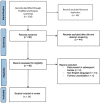Stapled Transanal Rectal Resection (Starr) in the Treatment of Obstructed Defecation: A Systematic Review
- PMID: 35237648
- PMCID: PMC8882820
- DOI: 10.3389/fsurg.2022.790287
Stapled Transanal Rectal Resection (Starr) in the Treatment of Obstructed Defecation: A Systematic Review
Abstract
Obstructed defecation syndrome (ODS) is a form of constipation that influences the quality of life in most patients and is an important health care issue. In 2004 Longo introduced a minimal invasive trans-anal approach known as Stapled Trans-Anal Rectal Resection (STARR) in order to correct mechanical disorders such as rectocele or rectal intussusception, two conditions present in more than 90% of patients with ODS. Considering the lack of a common view around ODS and STARR procedure. the aim of our study is to review the literature about preoperative assessment, operative features and outcomes of the STARR technique for the treatment of ODS. We performed a systematic search of literature, between January 2008 and December 2020 and 24 studies were included in this review. The total number of patients treated with STARR procedure was 4,464. In conclusion STARR surgical procedure has been proven to be safe and effective in treating symptoms of ODS and improving patients Quality of Life (QoL) and should be taken in consideration in the context of a holistic and multi modal approach to this complex condition. International guidelines are needed in order to optimize the diagnostic and therapeutic process and to improve outcomes.
Keywords: QOL; international guidelines; obstructed defecation syndrome; outcomes; stapled trans-anal rectal resection; surgical procedure.
Copyright © 2022 Ripamonti, Guttadauro, Lo Bianco, Rennis, Maternini, Cioffi, Chiarelli, De Simone, Cioffi and Gabrielli.
Conflict of interest statement
The authors declare that the research was conducted in the absence of any commercial or financial relationships that could be construed as a potential conflict of interest.
Figures
References
Publication types
LinkOut - more resources
Full Text Sources




